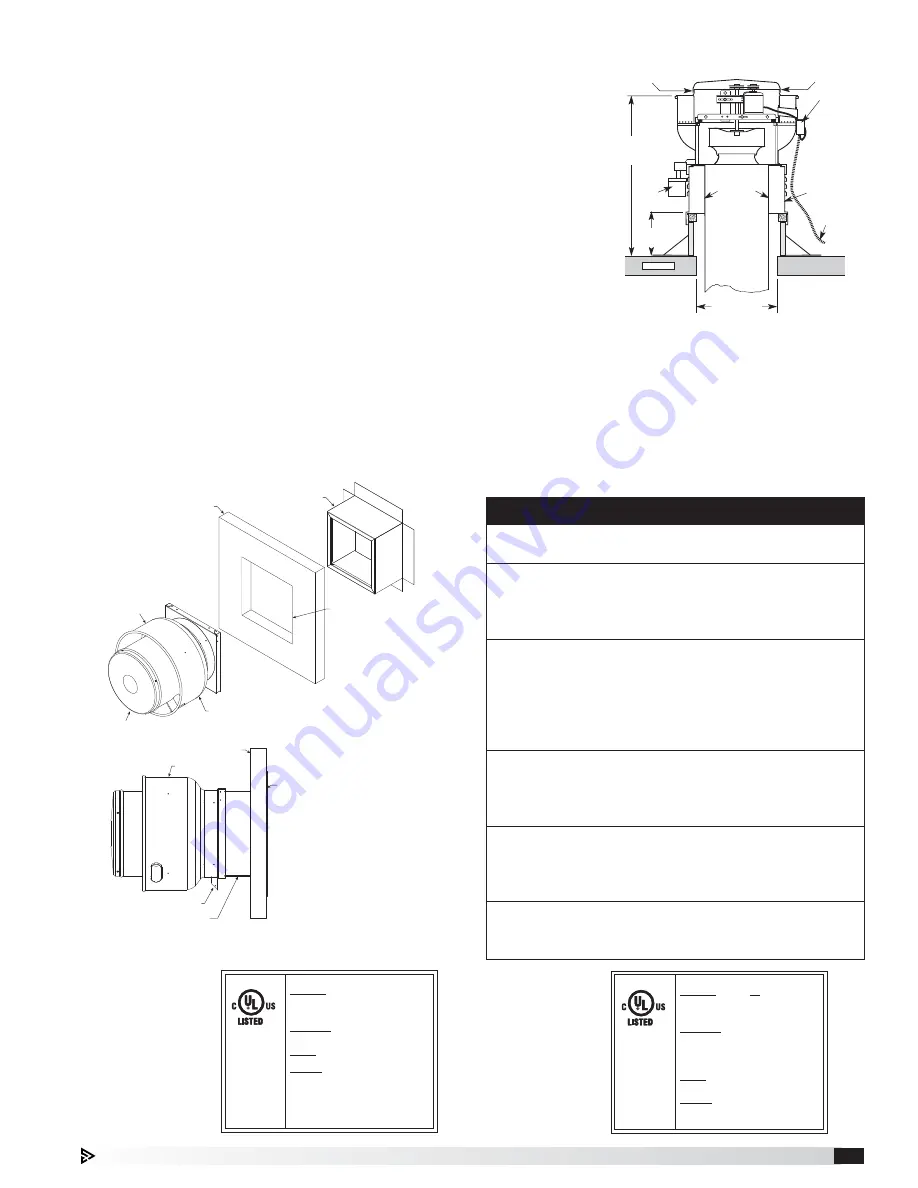
Upblast Centrifugal Roof Exhaust
5
Figure 8
Typical Roof Mounting Installation
Commercial Kitchen Installation
Commercial
kitchen
installations
must comply
with NFPA 96.
Check local
and national
codes for these
installations
and consult
local code
authorities for
other specific
requirements.
Power
Ventilator
565L
–Important–
ELECTRICAL
– If fan motor is NOT thermally protected, remote
overload protection must be installed having adequate rating as to
voltage, frequency, horsepower, and full load current per phase.
Where connected to a circuit protected by fuses, use time delay fuses.
For supply connection use wires rated for at least 90°C (194°F).
INSTALLATION
– When connecting electrical power to this fan,
GRQRWUHVWULFWPRWRUPRYHPHQW0RWRUPXVWKDYHVXI¿FLHQW
movement for possible future belt or wheel adjustment.
CAUTION
– Any fan inlet or outlet that is non-ducted must be
protected by an appropriate guard.
ATTENTION
– Tout ouverture d’admission ou de refoulement
du ventilateur non raccordée à une gaine doit comporter une
protection adaptée.
460420
Representation of
UL Listed
Power Ventilator
label
Sidewall Mounting Installation
1. Cut an appropriate sized hole in the wall and follow
manufacturer's instructions on curb installation.
Mount the curb to the interior of the wall with
a minimum of eight 3/8-inch fasteners around
the flange. Caulk and flash the curb to ensure a
watertight seal.
2. If unit is equipped with a backdraft damper, it
should be installed now.
3. Lift the fan into place. Do NOT support the unit by
the hoodband during installation.
4. Orient fan so the grease trough is downward and
secure fan to curb using a minimum of eight lag
screws, metal screws or other suitable fasteners.
5. Follow steps 6 through 12 of General Ventilation
Installation instructions on page 4.
Unit
Wall Opening
Standard
Roof Curb
Wall
Hoodband
Grease Trough
Pointed Down
Unit
Wall
Grease Trough
Standard Roof Curb
Secure standard
roof curb flange
to wall opening
Minimum of
(8) 3/8 inch
fasteners around
the flange
Figure 7 - Typical Sidewall Mounting Installation
Vari-Green
®
Wiring
For Vari-Green wiring refer to the Vari-Green Motor
and Controls Installation, Operation and Maintenance
Manual for complete wiring and operation instructions.
1. On the roof surface, cut an appropriate sized hole
and follow manufacturer’s instructions on curb
installation. Caulk and flash the curb to ensure a
watertight seal.
2. If unit is equipped with a backdraft damper. DO NOT
install it.
Perform steps 3 - 12 of General Ventilation Installation.
IMPORTANT
The size of the duct must be equal to or larger than
the inlet opening of the fan.
To comply with NFPA 96, the fan discharge must be a
minimum of 40 in.
(1016 mm)
above the roof surface
and a minimum of 10 ft.
(3048 mm)
from any building
air intake.
Per NFPA 96, ductwork to an upblast discharge
exhaust fan must be constructed of and supported
by carbon steel not less than No. 6 MSG
(1.52 mm)
or
stainless steel not less than No. 18 MSG
(1.21 mm)
in
thickness. Duct must also extend a minimum of 18 in.
(457 mm)
above the roof surface.
Ensure that a minimum of 500 ft/min of air velocity
through the duct is maintained per NFPA 96, clause
8.2.1.1, 2014 edition and UL 762, Issue #7, clause 6.2,
October 14, 2013.
The following accessories may be required by
NFPA 96 depending upon installation: Grease Trap,
Hinge Kit or Hinged Base, Clean-Out Port, and Vented
Curb.
Minimum duct velocities must be maintained in
kitchen exhaust applications. If a speed controller is
used, ensure compliance with all applicable codes.
461546
Power
Ventilator
Restaurant
Exhaust
Appliances
13G3
Maximum
Operating
Temperature
400°F
–Important–
ELECTRICAL
– If fan motor is NOT thermally protected, remote
overload protection must be installed having adequate rating as to
voltage, frequency, horsepower, and full load current per phase.
Where connected to a circuit protected by fuses, use time delay fuses.
For supply connection use wires rated for at least 90°C (194°F).
INSTALLATION
– When connecting electrical power to this fan,
do not restrict motor movement for possible future belt or wheel
adjustment.
Must be installed in accordance with the requirements to NFPA 96 or
must have minimum clearances of zero inches to non-combustibles,
3 inches to limited combustibles, 18 inches to combustibles.
CAUTION
– Mount with the lowest moving part at least 8 ft
PDERYHÀRRURUJUDGHOHYHO1RWUHTXLUHGRQURRIPRXQWHG
ventilators or duct mounted ventilators provided with belt guards.
ATTENTION
– Monter la pièce mobile la plus basse à au moins
2,5 m au-dessus du niveau du sol. Non requis pour les ventilateurs
montés sur un toit ou pour les ventilateurs montés sur gaine avec
protège-courroie.
Representation of
UL Listed
Power Ventilator
Restaurant
Exhaust
Appliances
label
Liquid Tight
Flexible Conduit
by Others
Recommended
Roof Opening
Roof Deck
Minimum 40 in.
(1016 mm)
Discharge Height
(per NFPA)
8 in. min.
(203 mm)
Screw
Screw
Optional
NEMA 3R
Disconnect
wired to
motor through
the breather
tube
Welded Duct
by others
minimum of
18 in. (457
mm) above
roof deck
(per NFPA)
Optional
Vented Curb
Extension
Optional
Grease
Trap






























